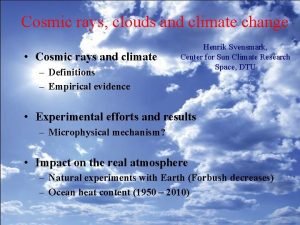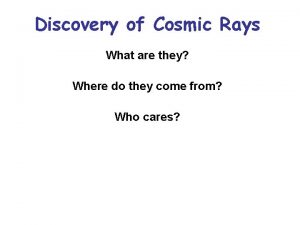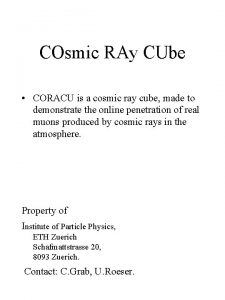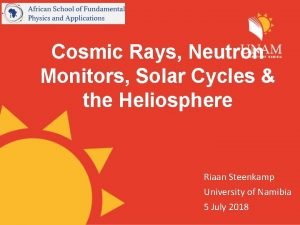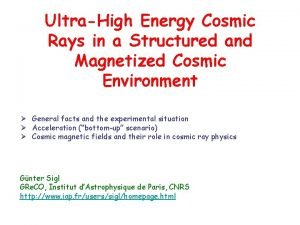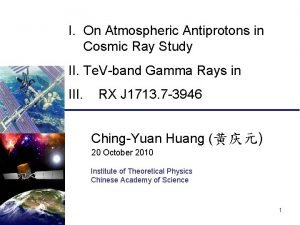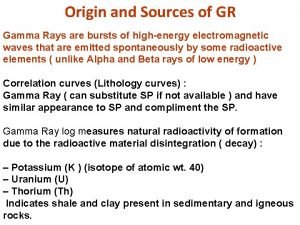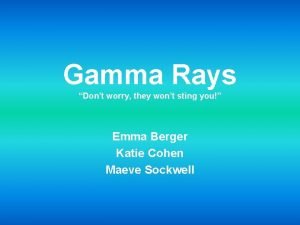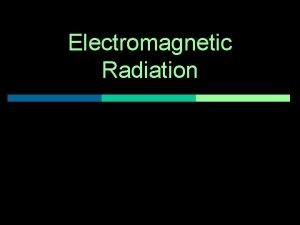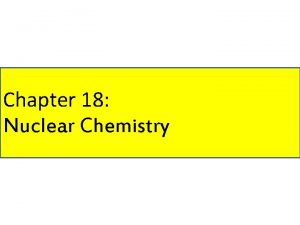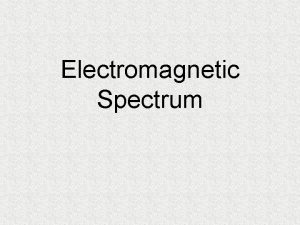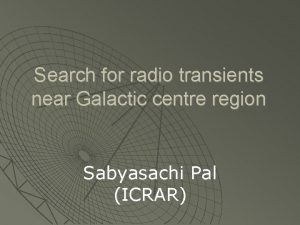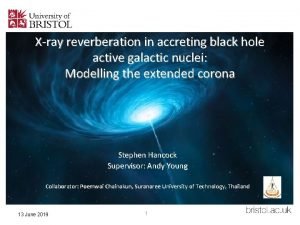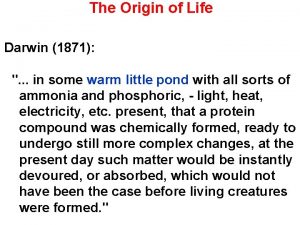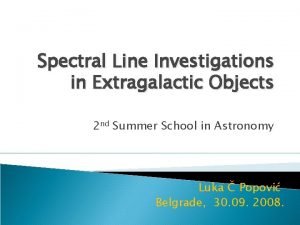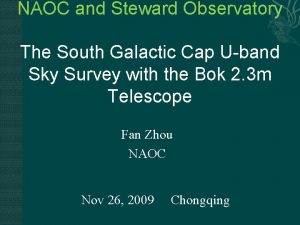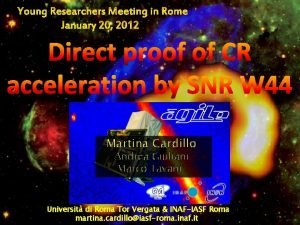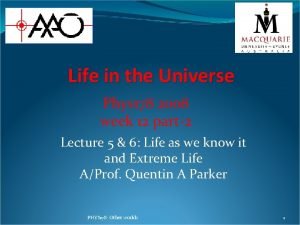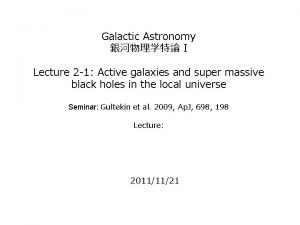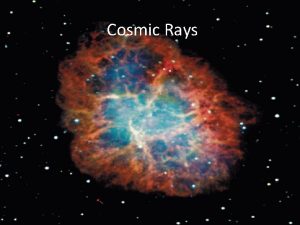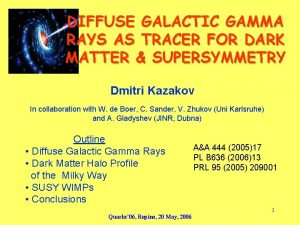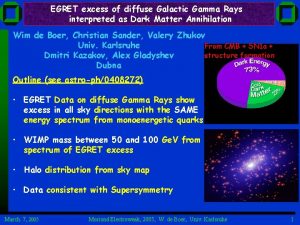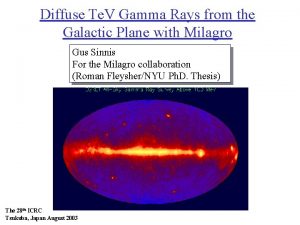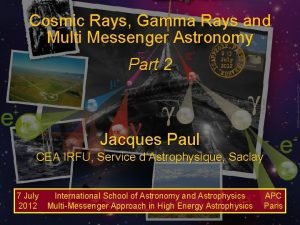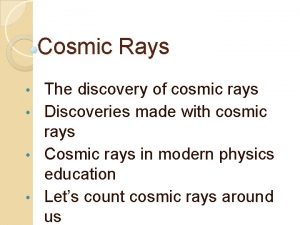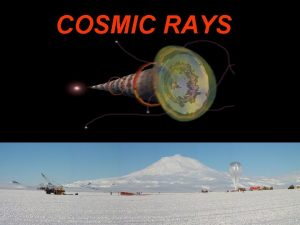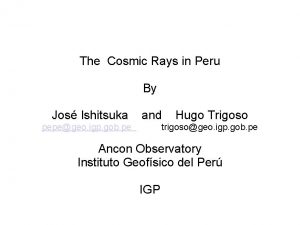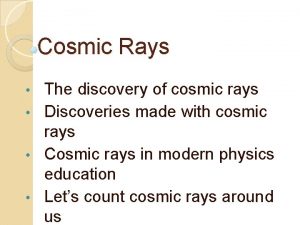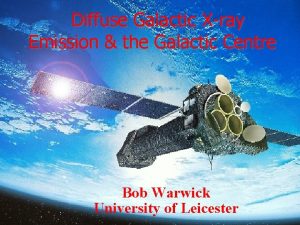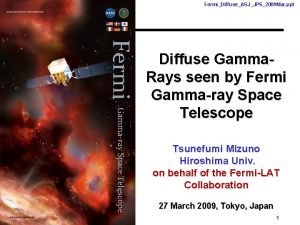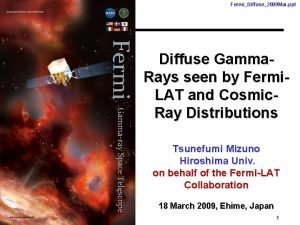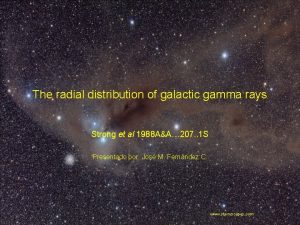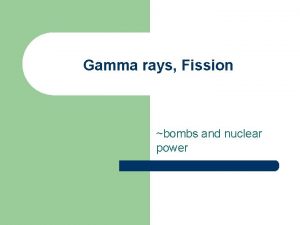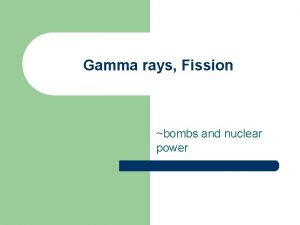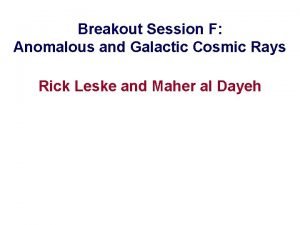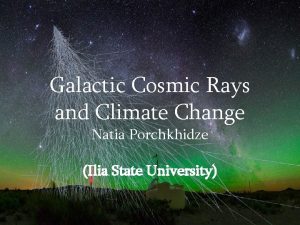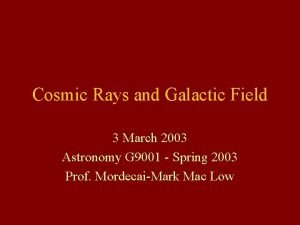Propagation of Cosmic Rays and Diffuse Galactic Gamma



























- Slides: 27

Propagation of Cosmic Rays and Diffuse Galactic Gamma Rays (nuclear physics in cosmic ray studies) Igor V. Moskalenko NASA Goddard Space Flight Center moskalenko@gsfc. nasa. gov with Andy W. Strong (MPE, Germany) & Stepan G. Mashnik (LANL)

All Particle CR Spectrum Synchrotron radiation of ultrarelativistic electrons: evidence of particle acceleration, but not protons… Energetically SNR – most probable sources of CR: ~5 x 1049 erg per SN (1/30 yr-1) – 5% of the kinetic energy of the ejecta. CR propagate in the Galaxy for some 10 Myr before escape. Igor V. Moskalenko/NASA-GSFC 2 Nuclear Data-2004/09/26 -10/1 Santa Fe, NM

EGRET Sky: “Ge. V Excess” Hunter et al. 1997 Excess The diffuse γ-ray emission is the dominant feature of the γ-ray sky – an evidence of CR interactions in the interstellar medium: bremsstrahlung, IC, π0 Igor V. Moskalenko/NASA-GSFC 3 Nuclear Data-2004/09/26 -10/1 Santa Fe, NM

Reacceleration Model: Secondary Pbars B/C ratio Antiproton flux Ek, Ge. V/nucleon Igor V. Moskalenko/NASA-GSFC 4 Nuclear Data-2004/09/26 -10/1 Santa Fe, NM

Positron Excess ? HEAT (Coutu et al. 1999) e+/e Ø Are all the excesses connected somehow ? Ø A signature of a new physics (DM) ? GALPROP Leaky-Box 1 10 100 E, Ge. V Igor V. Moskalenko/NASA-GSFC 5 Caveats: Ø Systematic errors ? Ø A local source of primary positrons ? Ø Large E-losses -> local spectrum… Nuclear Data-2004/09/26 -10/1 Santa Fe, NM

Propagation of Cosmic Rays: Why? Modeling of the CR propagation and diffuse gammaray emission requires to combine many different kinds of data obtained from astrophysical observations, and nuclear and particle physics experiments. Why Do We Need to Study CR Propagation ? In return, a correct model provides a basis for many studies in Astrophysics, Particle Physics, and Cosmology Igor V. Moskalenko/NASA-GSFC 6 Nuclear Data-2004/09/26 -10/1 Santa Fe, NM

Dark Matter Signatures in CR Diffuse gammas Antiprotons E, Ge. V Ek, Ge. V Well. . . But where is the nuclear physics? ! Igor V. Moskalenko/NASA-GSFC 7 Nuclear Data-2004/09/26 -10/1 Santa Fe, NM

CR Propagation: Milky Way Galaxy 1 kpc~3 x 1018 cm 0 10 NGC 891 pc Optical image: Cheng et al. 1992, Brinkman et al. 1993 Radio contours: Condon et al. 1998 AJ 115, 1693 Halo 0. 1 -0. 01/ccm 40 kp c Ga 1 - s, 10 so 0/ urc cc es m 4 - 12 kp c Sun R Band image of NGC 891 1. 4 GHz continuum (NVSS), 1, 2, … 64 m. Jy/ beam Igor V. Moskalenko/NASA-GSFC 8 Intergalactic space Nuclear Data-2004/09/26 -10/1 Santa Fe, NM

CR Interactions in the Interstellar Medium Sources: SNRs, Shocks, Superbubbles Particle acceleration Photon emission ISM X, γ e +- B P diffusion He energy losses CNO reacceleration convection e +etc. + π_ P Halo p solar modulation disk escape BESS Igor V. Moskalenko/NASA-GSFC 9 gas ron t o r h sync Chandra IC ISRF s brems gas π0 GLAST Li. Be. B He CNO ACE AMS Nuclear Data-2004/09/26 -10/1 Santa Fe, NM

Flux Heliosphere 20 Ge. V/n Igor V. Moskalenko/NASA-GSFC 10 Nuclear Data-2004/09/26 -10/1 Santa Fe, NM

Transport Equation sources (SNR, nuclear reactions…) diffusion convection diffusive reacceleration E-loss fragmentation convection radioactive decay ψ(r, p, t) – density per total momentum Igor V. Moskalenko/NASA-GSFC 11 Nuclear Data-2004/09/26 -10/1 Santa Fe, NM

Elemental Abundances: CR vs. Solar System CR abundances: ACE O Si Na Fe S CNO Al Cl Li. Be. B Cr. Mn F Sc. Ti. V Solar system abundances Igor V. Moskalenko/NASA-GSFC 12 Nuclear Data-2004/09/26 -10/1 Santa Fe, NM

Nuclear component in CR: What we can learn? Stable secondaries: Li, Be, B, Sc, Ti, V Propagation parameters: Radio (t 1/2~1 Myr): Diffusion coeff. , halo size, Alfvén speed, 10 Be, 26 Al, 36 Cl, 54 Mn convection velosity… K-capture: 37 Ar, 49 V, 51 Cr, 55 Fe, 57 Co Energy markers: Reacceleration, solar modulation Short t 1/2 radio 14 C & heavy Z>30 Heavy Z>30: Cu, Zn, Ga, Ge, Rb Local medium: Local Bubble o. Nuclesis: synthneovae, superniverse, u early Bang… Big Dark Matt (p, đ, e +er , γ) Extragalactic diffuse γ-rays: blazars, relic neutralino Material & acceleration sites, nucleosynthesis (rvs. s-processes) Igor V. Moskalenko/NASA-GSFC 13 Nuclear Data-2004/09/26 -10/1 Solar on lati modu Santa Fe, NM

Fixing Propagation Parameters: Standard Way Using secondary/primary nuclei ratio: • Diffusion coefficient and its index • Propagation mode and its parameters (e. g. , reacceleration VA, convection Vz) te r st e lla r B/C In Be 10/Be 9 Ek, Me. V/nucleon Radioactive isotopes: Galactic halo size Zh Zh increase Ek, Me. V/nucleon Igor V. Moskalenko/NASA-GSFC 14 Nuclear Data-2004/09/26 -10/1 Santa Fe, NM

K-capture isotopes Electron attachment & stripping Time scale (years) 51 Cr 51 V/51 Cr attachment ≡ daughter/parent K-capture & reacceleration stripping 51 V/51 Cr Solar modulation effect 51 V/51 Cr EC decay ISM Ek, Me. V/nucleon Jones et al. 2001 Ek, Me. V/nucleon Niebur et al. 2003 Ek, Me. V/nucleon Igor V. Moskalenko/NASA-GSFC 15 Nuclear Data-2004/09/26 -10/1 Santa Fe, NM

First Ionization Potential (FIP) vs. Volatility Rb Cs Na K Ga Cu Ge Pb ~104 K Igor V. Moskalenko/NASA-GSFC 16 Se Zn • Low-FIP ~ Refractories • Rb, Cs – break the rule • Other important elements: Na, Cu, Zn, Ga, Ge, Pb Nuclear Data-2004/09/26 -10/1 Santa Fe, NM

Effect of Cross Sections: Radioactive Secondaries Different size from different ratios… 27 Al+p 26 Al T 1/2=? W ST ST nat. Si+p 26 Al W Zhalo, kpc Ek, Me. V/nucleon Igor V. Moskalenko/NASA-GSFC 17 • Errors in CR measurements (HE & LE) • Errors in production cross sections • Errors in the lifetime estimates • Different origin of elements (Local Bubble ? ) Nuclear Data-2004/09/26 -10/1 Santa Fe, NM

Bigger picture… Igor V. Moskalenko/NASA-GSFC 18 Nuclear Data-2004/09/26 -10/1 Santa Fe, NM

Matter, Dark Energy… Ω ≡ ρ/ρcrit Ωtot =1. 02 ΩMatter =4. 4% ΩDM =23% ΩVacuum =73% +/− 0. 02 +/− 0. 4% +/− 4% SUSY DM candidate has also other reasons to exist -particle physics… Supersymmetry is a mathematically beautiful theory, and would give rise to a very predictive scenario, if it is not broken in an unknown way which unfortunately introduces a large number of unknown parameters… Lars Bergström (2000) Igor V. Moskalenko/NASA-GSFC 19 Nuclear Data-2004/09/26 -10/1 Santa Fe, NM

Example “Global Fit: ” diffuse γ’s, pbars, positrons GALPROP/W. de Boer et al. hep-ph/0309029 Supersymmetry: Ø Ø Ø MSSM Lightest neutralino χ0 mχ ≈ 100 -500 Ge. V S=½ Majorana particles χ0χ0−> p, pbar, e+, e−, γ γ pbars Ø Look at the combined (pbar, e+, γ) data Ø Possibility of a successful “global fit” can not be excluded -non-trivial ! Ø If successful, it may provide a strong evidence for the SUSY DM Igor V. Moskalenko/NASA-GSFC 20 Nuclear Data-2004/09/26 -10/1 e+ Santa Fe, NM

CR Fluctuations/SNR stochastic events Ge. V electrons 100 Te. V electrons E(d. E/dt)-1, yr GALPROP/Credit S. Swordy 107 yr 106 yr Electron energy losses Bremsstrahlung Ionization Coulomb Historical variations of CR intensity over 150 000 yr (Be 10 in South Polar ice) IC, synchrotron 1 Ge. V 1 Te. V Konstantinov et al. 1990 Ekin, Ge. V Igor V. Moskalenko/NASA-GSFC 21 Nuclear Data-2004/09/26 -10/1 Santa Fe, NM

Ge. V excess: Optimized model Uses all sky and antiprotons & gammas to fix the nucleon and electron spectra antiprotons Ø Uses antiprotons to fix the intensity of CR nucleons @ HE Ø Uses gammas to adjust q the nucleon spectrum at LE q the intensity of the CR electrons (uses also synchrotron index) Ø Uses EGRET data up to 100 Ge. V electrons Ek, Ge. V protons x 4 x 1. 8 Ek, Ge. V Igor V. Moskalenko/NASA-GSFC 22 Ek, Ge. V Nuclear Data-2004/09/28, Santa Fe

Longitude Profiles |b|<5° 50 -70 Me. V 0. 5 -1 Ge. V 2 -4 Ge. V Igor V. Moskalenko/NASA-GSFC 23 4 -10 Ge. V Nuclear Data-2004/09/26 -10/1 Santa Fe, NM

Predicted vs. observed E 2 x. F Extragalactic Gamma-Ray Background Sreekumar et al. 1998 Elsaesser & Mannheim, astro-ph/0405235 Strong et al. 2004 E, Me. V • Blazars • Cosmological neutralinos E, Ge. V Igor V. Moskalenko/NASA-GSFC 24 Nuclear Data-2004/09/26 -10/1 Santa Fe, NM

Conclusions I Accurate measurements of nuclear species in CR, secondary antiprotons, and diffuse γ-rays simultaneously may provide a new vital information for Astrophysics – in broad sense, Particle Physics, and Cosmology. Hunter et al. region: l=300°-60°, |b|<10° Gamma rays: GLAST is scheduled to launch in 2007 – diffuse gamma rays is one of its priority goals B/C Be 10/Be 9 Zh increase Ek, Me. V/nucleon Igor V. Moskalenko/NASA-GSFC 25 Ek, Me. V/nucleon Dark Matter CR species: New measurements at LE & HE simultaneously are highly desirable (Pamela, Super-TIGER, AMS…), also sec. positrons ! Nuclear Data-2004/09/26 -10/1 Santa Fe, NM

Conclusions II Antiprotons: Pamela (2005), AMS (2008) and a new BESS-polar instrument to fly a longduration balloon mission (in 2004, 2006…), we thus will have more accurate and restrictive antiproton data HE electrons: Several missions are planned to target specifically HE electrons We must be ready…! GALPROP is a propagation model to play now; the accuracy depends very much on the accuracy of the nuclear production cross sections Igor V. Moskalenko/NASA-GSFC 26 Nuclear Data-2004/09/26 -10/1 Santa Fe, NM

Thank you ! Igor V. Moskalenko/NASA-GSFC 27 Nuclear Data-2004/09/26 -10/1 Santa Fe, NM
 Svensmark
Svensmark Cosmic rays discoverer
Cosmic rays discoverer Coracu
Coracu Cosmic rays
Cosmic rays Cosmic rays
Cosmic rays Cosmic ray
Cosmic ray Origin of gamma rays
Origin of gamma rays Gamma rays who discovered
Gamma rays who discovered Gamma rays uses
Gamma rays uses Gamma rays in agriculture
Gamma rays in agriculture Images of gamma rays
Images of gamma rays Characteristics of ultraviolet rays
Characteristics of ultraviolet rays Focus mode and diffuse mode
Focus mode and diffuse mode Effuse and diffuse
Effuse and diffuse Galactic headquarters map
Galactic headquarters map Galactic city model
Galactic city model Combine vs galactic empire
Combine vs galactic empire Models of urban structure
Models of urban structure Peripheral model
Peripheral model Galactic center radio transients
Galactic center radio transients Reverberation
Reverberation Galactic habitable zone
Galactic habitable zone Active galactic nuclei
Active galactic nuclei Galactic phonics ure
Galactic phonics ure Galactic cap review
Galactic cap review Martina cardillo
Martina cardillo Galactic habitable zone
Galactic habitable zone Active galactic nuclei
Active galactic nuclei
